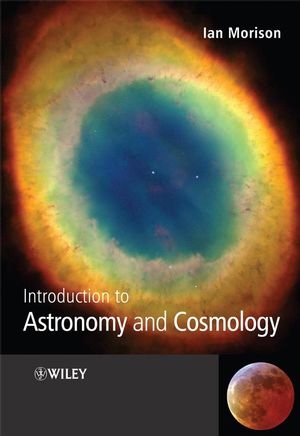Introduction to Astronomy and CosmologyISBN: 978-0-470-03334-0
Paperback
360 pages
December 2008
 This is a Print-on-Demand title. It will be printed specifically to fill your order. Please allow an additional 10-15 days delivery time. The book is not returnable.
Other Available Formats: Hardcover
|
||||||
Bibliography.
Chapter 1: Astronomy, an Observational Science.
1.1 Introduction.
1.2 Galileo Galilel’s proof of the Copernican theory of the solar system.
1.3 The celestial sphere and stellar magnitudes.
1.4 The celestial coordinate system.
1.5 Precession.
1.6 Time.
1.7 A second major observational triumph: the laws of planetary motion.
1.8 Measuring the astronomical unit.
1.9 Isaac Newton and his Universal law of Gravity.
1.10 Experimental measurements of G, the Universal constant of gravitation.
1.11 Gravity today: Einstein’s special and general theories of relativity.
1.12 Conclusion.
1.13 Questions.
Chapter 2: Our Solar System 1 – The Sun.
2.1 The formation of the solar system.
2.2 The Sun.
2.3 Nuclear fusion.
2.4 The solar neutrino problem.
2.5 The solar atmosphere: photosphere, chromosphere and corona.
2.6 The solar wind.
2.7 The sun’s magnetic field and the sunspot cycle.
2.8 Prominences, flares and the interaction of the solar wind with the earth’s atmosphere.
2.9 Solar eclipses.
2.10 Questions.
Chapter 3: Our Solar System 2 – The Planets.
3.1 What is a planet?
3.2 Planetary orbits.
3.3 Planetary properties.
3.4 Planetary atmospheres.
3.5 The planets of the solar systems.
3.6 Comets.
3.7 Questions.
Chapter 4: Extra-solar Planets.
4.1 The radial velocity (Doppler wobble) method of planetary detection.
4.2 Planetary transits.
4.3 Gravitational microlensing.
4.4 Astrometry.
4.5 Discovery space.
4.6 Selection effects and the likelihood of finding solar systems like ours.
4.7 Questions.
Chapter 5: Observing the Universe.
5.1 Thinking about optics in terms of waves rather than rays.
5.2 The human eye.
5.3 The use of a telescope or pair of binoculars to see fainter objects.
5.4 Using a telescope to see more detail in an image.
5.5 The magnification of a telescope.
5.6 Image Contrast.
5.7 The classic Newtonian telescope.
5.8 The Cassegrain telescope.
5.9 Catadioptric telescopes.
5.10 Active and adaptive optics.
5.11 Some significant optical telescopes.
5.12 Radio telescopes.
5.13 Observing in other wavebands.
5.14 Observing the universe without using electromagnetic radiation.
5.15 Questions.
Chapter 6: The Properties of Stars.
6.1 Stellar luminosity.
6.2 Stellar distances.
6.3 Proper motion.
6.4 The absolute magnitude scale.
6.5 Colour and surface temperature.
6.6 Stellar photometry.
6.7 Stellar spectra.
6.8 Spectroscopic parallax.
6.9 The Hertzsprung-Russell Diagram.
6.10 The size of stars.
6.11 The masses and densities of stars.
6.12 The stellar mass-luminosity relationship.
6.13 Stellar lifetimes.
6.14 Questions.
Chapter 7: Stellar Evolution – The Life and Death of Stars.
7.1 Low mass stars: 0.05-0.5 solar masses.
7.2 Mid mass stars: 0.5—8 solar masses.
7.3 Variable stars.
7.4 Planetary nebula.
7.5 White dwarfs.
7.6 The evolution of a sun-like star.
7.7 Evolution in close binary systems – the Algol paradox.
7.8 High mass stars in the range >8 solar masses.
7.9 Type II supernova.
7.10 Neutron stars and black holes.
7.11 The discovery of pulsars.
7.12 Pulsars as tests for general relativity.
7.13 Black holes.
7.14 Questions.
Chapter 8: Galaxies and the Large Scale Structure of the Universe.
8.1 The Milky Way.
8.2 Other galaxies.
8.3 The universe.
8.4 Questions.
Chapter 9: Cosmology – the Origin and Evolution of the Universe.
9.1 Einstein’s blunder?
9.2 Big Bang models of the universe.
9.3 The blueshifts and redshifts observed in the spectra of galaxies.
9.4 The expansion of the universe.
9.5 The steady state model of the universe.
9.6 Big Bang or Steady State?
9.7 The cosmic microwave background.
9.8 Inflation.
9.9 The Big Bang and the formation of the primeval elements.
9.10 The ‘ripples’ in the Cosmic Microwave Background.
9.11 How dark matter effects the cosmic microwave background.
9.12 The hidden universe: dark matter and dark energy.
9.13 The makeup of the universe.
9.14 A universe fir for intelligent life.
9.15 Intelligent life in the universe.
9.16 The future of the universe.
Index.



